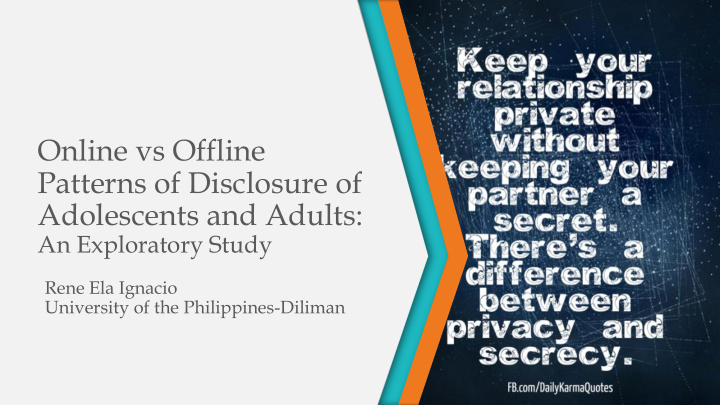



Online vs Offline Patterns of Disclosure of Adolescents and Adults: An Exploratory Study Rene Ela Ignacio University of the Philippines-Diliman
What I wanted to find out: Step 1 • How do adolescents and adults construe privacy? Does this notion hold true both for online disclosure and face-to-face (FTF) disclosure? • What are the things that adolescents and adults share on their Facebook (FB) timeline and during their FTF communication? • experiences • thoughts and opinions • With whom do they share these information?
So, what’s already known: Step 1 Step 2 • ‘secrecy paradigm’ ( Solove, 2004) • keeping information to ourselves (and with close others) • sense of privacy can be extended to chosen others • There are high levels of self-disclosure in the FB profiles of adolescents (Tufekci, 2008; Kolek, 2008). • Casual exchanges (which include the use of FB) help adolescents maintain a sense of connection and belonging to their peers (Davis, 2012).
So, what’s already known: Step 1 Step 2 • People reveal superficial information about themselves online (Attrill & Jalil, 2011). • CMC enhances quantity rather than quality of online exchanges. • Digital natives and igital immigrants (Prensky, 2001) • Digital natives and digital immigrants vary in their use of the Internet (Ignatius and Hechanova, 2014).
How I tried and managed to find out: Step 1 Step 2 Step 3 • Five (5) adolescents with a mean age of 19.4 from one of the universities in Metro Manila and five (5) adults with a mean age of 43.6 from Metro Manila were interviewed. • The interviews were analyzed in order to identify common themes in (1) content that were shared via both media and (2) patterns of disclosure via both media.
What I found out: content Step 1 Step 2 Step 3 Step 4 • Almost all of the adolescent participants post a wide range of topics (personal matters, family, friends, school, org, extra-curricular activities etc) on their FB timeline that somewhat overlap with what they share during FTF communication. However, especially for the topics they consider personal, the participants limit the information they post online. • “Well, it’s like I have nothing to hide. … (But) There are details na I can only share to my close friends so I just say it to them directly.” (adolescent 2 ) • “ There are people in my Facebook that I really don’t know so there’s a need for me to filter (information) when I post. “ (adolescent 5 )
What I found out: content Step 1 Step 2 Step 3 Step 4 • There are some topics that are only shared during FTF communication. These topics are very personal in nature such as issues with parents and personal crisis. • One adolescent participant had totally different topics which she posted on her FB timeline and shared during FTF communication. • “I post like mainstream stuff. Pero pag personal na like nag-away yung parents ko, syempre sa personal ko siya sinasabi .”
What I found out: content Step 1 Step 2 Step 3 Step 4 • Almost all of the adult participants rarely share on their FB timeline. However, they share various topics (personal matters, family, friends, work, politics) during FTF communication. • “( sa FB) susuyurin ko pa ‘ yung pwedeng makita ng anybody (na) I will be okay. Sa face-to-face, I know. I know that I can share… I have that flexibility.” (adult 3) • “ Nagpost lang ako ng malungkot na song (‘Good M orning Heartache’) tinawagan na ako. Naghiwalay na daw ba kami ni misis . ... I don’t want to be misquoted or misunderstood. If you want to know something, kausapin mo na lang ako. PM mo ako. Nagiging chismis kasi pagpost .” (adult 5)
What I found out: pattern Step 1 Step 2 Step 3 Step 4 Adolescents Adults • During FTF, breadth and depth of • During FTF, breadth and depth of the topic depends on their the topic depends on their relationship with the other relationship with the other person. person. • FB posts that contain general or • Carefully chosen topics are posted vague information are posted for on their FB timeline for all their all FB friends to read. FB friends to read. • Two adolescent participants mentioned, though, that there are posts they hide from their parents.
Where to go from here: • Extend the study • Methodologically • Inclusion of other aspects that can affect disclosure such as personality, identity, and impression management
Thank you very much for listening. Rene Ela P. Ignacio University of the Philippines-Diliman rene_ela@yahoo.com
Recommend
More recommend